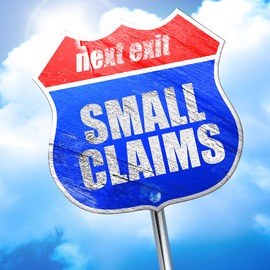“The patent system excludes many patentees that it is supposed to include. It is irrationally expensive to pursue an infringement claim when claimable damages are relatively small.”
 Gene Quinn’s recent post tells only half the story of how badly the FTC misunderstands patent economics. He ably shows the absurdity of the FTC using $300,000 as a magic touchstone of “nuisance” value. But there is so much more that the FTC missed, not mentioned in the post.
Gene Quinn’s recent post tells only half the story of how badly the FTC misunderstands patent economics. He ably shows the absurdity of the FTC using $300,000 as a magic touchstone of “nuisance” value. But there is so much more that the FTC missed, not mentioned in the post.
I asked an important question in a 2009 article, right in its title: “Is the United States Ready for a Patent Small Claims Court?” 10 Minn. J. L. Sci. Tech. 549 (2009). Back then, the answer was resoundingly “yes.” The patent system excludes many patentees that it is supposed to include. It is irrationally expensive to pursue an infringement claim when claimable damages are relatively small. Availability of contingency fee counsel does not help.
I concluded then that the patent system is not working for a large population of deserving patentees. I called for, and suggested, a fix – to establish a patent small claims court so that the patent system could begin to work for all of its constituents. By 2013, my article had spurred seminars, panel discussions, and calls by the USPTO under Director David Kappos for comments on the concept of a patent small claims court. Many comments supported the concept. Some opposed it. The debate was lively.
Fast forward to 2016. The FTC not only did not take notice of this underserved group. Its “nuisance suit” narrative only hurts it more. The FTC, in the recent Report, ignores the crucial constituency of deserving patentees who never get to enjoy the job-creating and startup-boosting effects of patent ownership. And the FTC also missed the fact that recent developments only make things worse for deserving small patent claimants.
Despite the headlines, most infringement is small infringement. The FTC report ignores three important sea changes in the patent ecosystem that should, if anything, obliterate the use of settlement demand amounts or final license fees as any touchstone of bad faith. These are (1) the ten-year long movement to “rationalize” (actually, reduce) patent damages, (2) the “thumb on the scales” given to accused infringers in recent court holdings and legislation (primarily Alice invalidation, revitalized obviousness doctrine, and no-upside-but-everything-to-lose PTAB proceedings), and (3) increased infringer opportunities to extract monetary awards from plaintiff-patentees (Octane/Highmark).
All combined, these create a vicious cycle against good faith rights holders. More than ever, patentees should be praised, not vilified, when giving infringers opportunities to avoid the full cost burdens of litigation. The fact should at least be off limits to those who would use it to make moral judgments. Claimable damages are going down. Amplifying this change, the probability of patent owner success in getting a liability judgment is declining, too. The rational patentee reaction to these changes beyond the patentee’s control is to lower settlement demands. But some misguided Federal Circuit decisions have endorsed using this good faith response as its own justification for punishing patentees with Section 285 fee shifting. The argument mirrors the FTC’s: If a settlement demand is below someone’s idea of litigation costs, it smells.
The vicious cycle continues to turn. The possibility itself that infringers can use the fact of low settlement demands to shift fees increases litigant risks, and ironically drives rational settlement demands lower. The ultimate goal held by some is to destroy the patent system. And in some ways it’s working. The drumbeat of anti-patentee developments has become its own justification for beating the drum more and louder. An important balancing fact (suggested in Gene’s post) has gone missing from the public conversation. Defense counsel (not patentee counsel) at least as prone to use litigation costs strategically (and immorally). Fortunately, at least one Federal Circuit panel got it right, rejecting a call to use settlement amounts alone, in a vacuum, as probative of “exceptionality” to support fee shifting.
Is it any wonder that in this perfect storm of devalued patent rights and enhanced risk in asserting them that “below litigation cost” license offers exist? The increasingly unfriendly environment itself should have given the FTC pause to suggest moral judgments about licensing outcomes below $300,000. And the FTC Report blinds itself to possible reasons that would justify low market values for a license in a given case (including immoral infringer actions using litigation costs to drive down settlements). As Jaime Siegel noted in Gene’s article, sometimes the right price for buying patent license rights is a low price. No one can prejudge the “correct” value of a given rights transfer without knowing all the valuation facts.
It is possible that the FTC knows all of this, but chose a nuisance narrative to fit the current political winds. The report’s wording seems to point in that direction. For instance, the FTC’s $300,000 nuisance narrative carefully states that below-litigation-cost settlements are “consistent with” strategic litigation behavior, not that they are probative of it. Whoever wrote that must have known the truth. Whoever wrote that also must have known how the press (or whoever the intended audience is) would ignore all subtlety and formulate only anti-patentee talking points. We should expect better from our “expert” and “impartial” government agencies.

![[IPWatchdog Logo]](https://ipwatchdog.com/wp-content/themes/IPWatchdog%20-%202023/assets/images/temp/logo-small@2x.png)

![[Advertisement]](https://ipwatchdog.com/wp-content/uploads/2024/04/Patent-Litigation-Masters-2024-sidebar-early-bird-ends-Apr-21-last-chance-700x500-1.jpg)

![[Advertisement]](https://ipwatchdog.com/wp-content/uploads/2021/12/WEBINAR-336-x-280-px.png)
![[Advertisement]](https://ipwatchdog.com/wp-content/uploads/2021/12/2021-Patent-Practice-on-Demand-recorded-Feb-2021-336-x-280.jpg)
![[Advertisement]](https://ipwatchdog.com/wp-content/uploads/2021/12/Ad-4-The-Invent-Patent-System™.png)







Join the Discussion
No comments yet.